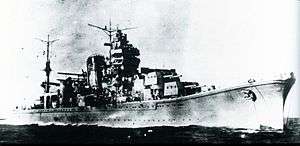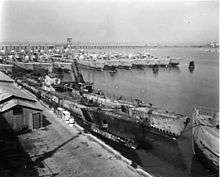USS Skate (SS-305)
.jpg) Skate after the atomic bomb test | |
| History | |
|---|---|
| Builder: | Mare Island Naval Shipyard[1] |
| Laid down: | 1 August 1942[1] |
| Launched: | 4 March 1943[1] |
| Commissioned: | 15 April 1943[1] |
| Decommissioned: | 11 December 1946[1] |
| Struck: | 21 October 1948[2] |
| Fate: | Sunk as a target off Southern California coast, 5 October 1948[2] |
| General characteristics | |
| Class and type: | Balao-class diesel-electric submarine[2] |
| Displacement: | |
| Length: | 311 ft 10 in (95.05 m) (95.0 m)[2] |
| Beam: | 27 ft 4 in (8.33 m)[2] |
| Draft: | 16 ft 10 in (5.13 m) maximum[2] |
| Propulsion: |
|
| Speed: | |
| Range: | 11,000 nautical miles (20,000 km) surfaced at 10 knots (19 km/h)[6] |
| Endurance: |
|
| Test depth: | 400 feet (120 m)[6] |
| Complement: | 10 officers, 70–71 enlisted[6] |
| Armament: |
|
USS Skate (SS-305) was a United States Navy Balao-class submarine named for the skate, a type of ray.
Skate was laid down at the Mare Island Naval Shipyard of Vallejo, California, 1 August 1942. She was launched on 4 March 1943, sponsored by Mrs. Ethel L. Shamer, wife of Captain George P. Shamer, Supply Officer of the Mare Island Naval Shipyard and commissioned on 15 April with Commander Eugene B. McKinney in command.
First War Patrol
Following shakedown off the California coast, Skate sailed to Pearl Harbor and on 25 September 1943, headed toward Wake Island and her first war patrol during which she performed lifeguard duty for the carriers during airstrikes against that Japanese-held island. At dawn on 6 October, the submarine was strafed by enemy aircraft, mortally wounding one of her officers, LtJg Willis Edward Maxson, III, as he attempted to assist wounded airmen from a liferaft. The next day, Skate closed to within 5,000 yards (4,600 m) of the beach, in the face of heavy enemy bombardment, to rescue two downed aviators. While searching for a third, she was attacked by a Japanese dive-bomber, and was forced to dive to escape. After a short return to Midway Island, Skate returned to Wake Island and rescued four additional airmen before terminating her first patrol at Midway on 29 October.
Second War Patrol
On 15 November, Skate departed Midway for her second war patrol, conducted off Truk in the Caroline Islands. On 25 November, she sighted the masts of five warships; but, after firing a spread of torpedoes at overlapping aircraft carriers, she was forced down by depth charging from the escort ships.
On 30 November, Skate attacked Japanese carriers Zuihō, Chuyō, and Unyō without success.[7]
While north of Truk on 21 December, the submarine torpedoed and sank the cargo ship Terukawa Maru. During a rain squall on Christmas Day 1943, she made a daring attack which badly damaged the battleship Yamato, the pride of the Japanese Fleet. Skate returned to Midway for refit on 7 January 1944.
Third and Fourth War Patrols

Skate's third war patrol was again conducted in the area of the Carolines, in support of Operation Hailstone, the carrier airstrikes on Truk. Skate departed Midway on 5 February, this time under the command of Lt. Commander W.P. "Bud" Gruner, Jr. On 16 February, the evening before the airstrike, Skate intercepted a Japanese light cruiser, which had survived a previous torpedo attack by submarine USS Scamp (SS-277). Skate launched four torpedoes for three certain hits that engulfed the ship in a shroud of smoke as the submarine submerged to evade heavy depth charging from the enemy escorts. She later returned to the scene of the attack, but before another torpedo could be launched, the cruiser rolled to port and sank. It was later determined the cruiser sunk was the Japanese light cruiser Agano. Following the airstrikes and further patrol in the area, the submarine returned to Pearl Harbor on 17 March.
During her fourth war patrol, off the Bonin Islands from 11 April to 31 May, Skate scored hits on an enemy cargo ship for unconfirmed damage and, on 14 May, sank an enemy sampan in a surface attack, taking three prisoners of war.
Fifth, Sixth and Seventh War Patrols
Skate departed Midway on 23 June on her fifth war patrol, conducted off the Kuril Islands. On 7 July, she intercepted a convoy of five ships and escorting destroyers, fired three torpedoes, and sank the trailing destroyer, Usugumo. The submarine was then forced deep by the other escorts and depth charged for over two hours before escaping. On 15 July, the submarine sank a cargo ship taking two prisoners and, on the following day, another cargo ship was also sent to the bottom. Skate terminated her fifth patrol at Pearl Harbor on 7 August.
Departing Pearl Harbor on 9 September, Skate sailed for the Ryukyu Islands and her sixth war patrol, during which she performed photographic reconnaissance of Okinawa and, on 29 September, sank a small patrol craft and a cargo ship. Following her return to Pearl Harbor, she got underway for overhaul at Hunters Point Navy Yard, San Francisco, California.
Skate got underway from Pearl Harbor for her seventh war patrol on 11 April 1945, to form a coordinated attack group with other submarines and patrol in the Sea of Japan. On the morning of 10 June, she encountered a Japanese submarine on the surface returning to port. As the enemy crossed her bow, Skate launched two torpedoes with two hits, sinking the target. Two days later, while off the Nanto Peninsula, she evaded gunfire of enemy ships and an attack by an enemy escort to sink three cargo ships. Skate terminated her seventh war patrol at Pearl Harbor on 4 July.

End of World War II and fate
Skate departed Pearl Harbor on 5 August for her eighth war patrol; but, while en route to the patrol area, she received word of the Japanese surrender and returned to port, and then set sail for the United States arriving at San Diego, on 6 September. For the next four months, she participated in training operations along the west coast, and then sailed to Pearl Harbor arriving on 9 January 1946. On 21 May, she departed for Bikini Atoll, Marshall Islands, to be used as a target ship in Operation Crossroads, the atomic bomb tests. Although considerably damaged by the first of the tests, the submarine survived and was towed back to Pearl Harbor, where she was moored in an isolated berth. On 11 October, salvage vessel Clamp took Skate in tow and headed for San Francisco, and then to Mare Island Naval Shipyard where the submarine was inspected and then decommissioned on 11 December. The submarine was destroyed on 5 October 1948, off the California coast, and struck from the Naval Vessel Register on 21 October 1948.
Awards
Skate received eight battle stars for World War II service.
References
- 1 2 3 4 5 Friedman, Norman (1995). U.S. Submarines Through 1945: An Illustrated Design History. Annapolis, Maryland: United States Naval Institute. pp. 285–304. ISBN 1-55750-263-3.
- 1 2 3 4 5 6 7 8 Bauer, K. Jack; Roberts, Stephen S. (1991). Register of Ships of the U.S. Navy, 1775–1990: Major Combatants. Westport, Connecticut: Greenwood Press. pp. 275–280. ISBN 0-313-26202-0.
- 1 2 3 4 5 Bauer, K. Jack; Roberts, Stephen S. (1991). Register of Ships of the U.S. Navy, 1775–1990: Major Combatants. Westport, Connecticut: Greenwood Press. pp. 271–280. ISBN 978-0-313-26202-9.
- ↑ U.S. Submarines Through 1945 pp. 261–263
- 1 2 3 U.S. Submarines Through 1945 pp. 305–311
- 1 2 3 4 5 6 U.S. Submarines Through 1945 pp. 305–311
- ↑ Cressman, Robert (2000). "Chapter V: 1943". The official chronology of the U.S. Navy in World War II. Annapolis, Maryland: Naval Institute Press. ISBN 978-1-55750-149-3. OCLC 41977179. Retrieved 2007-11-30.
- This article incorporates text from the public domain Dictionary of American Naval Fighting Ships. The entry can be found here.